Insects and Spiders
Embryonic Development of the Light-Brown Apple Moth
Another contender in the Great Boredom Sweepstakes.
Posted By: Paul - Sat Sep 21, 2024 -
Comments (0)
Category: Boredom, Education, Insects and Spiders, PSA’s, Science, 1960s
The Spider That Waged A Battle Against A Clock
I wrote this article about eight years ago for a site that has now gone dark. So I'm reposting it here.The Internet has made many animals famous, such as Grumpy Cat, Darwin the Ikea Monkey, and Sockington the Twitter Cat. But as this brief list suggests, Internet-famous animals tend to be either pets or species that biologists describe as "charismatic" — meaning ones that people can easily identify with. Insects don't get much love.
This hasn't always been the case. If we look back to 1932, we find an example of a spider that achieved overnight celebrity status, with the media producing daily reports of its adventures. It's the curious case of the "spider in a clock."
Closer examination by her husband, Cyril, revealed that the dot was a small spider. It had somehow gotten into the space between the face of the clock and the glass, and it was attempting to spin a web between the minute and hour hands. It succeeded in briefly attaching a fine thread of gossamer between the two hands, but as the minute hand slowly advanced the thread broke. No matter. The spider climbed up the face of the clock and began its effort all over again, only to have the thread broken for a second time. The couple watched as the spider continued to repeat this cycle over and over.
The next morning the spider was still there, still trying to build its ill-fated web. And it remained there the day after, and the day after that.
The Thompsons shared the story of the clock-battling spider with their neighbors, and soon people started dropping by to see it. Eventually, someone contacted the media.
How had the spider managed to grow without any obvious source of food? And how had it gotten into the clock in the first place? These were the mysteries that the spider presented.
The reporter interviewed the Thompson's two children. Young tommy thought the spider was boring, but his sister, Mary Louise, was fascinated by it, admiring the way it kept at its task despite constant defeat. She said, "He must be awfully brave."

Wilkes Barre Times Leader - Dec 10, 1932
Evidently much of the American public agreed with Mary Louise, because after the first story about the spider (distributed by the Associated Press) appeared in papers, interest in the arachnid swelled. The media responded by providing daily details of its adventures.
More in extended >>
Posted By: Alex - Sat Sep 14, 2024 -
Comments (1)
Category: Insects and Spiders, 1930s
Follies of the Madmen #603
Don't bees have intimate relations with (swimsuit women) flowers?
Posted By: Paul - Tue Aug 20, 2024 -
Comments (3)
Category: Fashion, Insects and Spiders, Swimming, Snorkeling, and Diving, Advertising, 1950s
Dr. Robert Lopez Infects Himself with Cat Ear Mites
Yesterday, Alex regaled us with the report of a fellow who swallowed a giraffe liver parasite in the pursuit of knowledge.Well, here's another scientist who wanted to learn what cats went through with an ear mite infestation, choosing to insert them into his own ears.
There's a tremendous long piece about him here, even including a video!

Posted By: Paul - Wed Jul 24, 2024 -
Comments (4)
Category: Awards, Prizes, Competitions and Contests, Hobbies and DIY, Insects and Spiders, Mad Scientists, Evil Geniuses, Insane Villains, Science, Cats, 1990s
Bipartite Insect-Excluding Airlock
This seems like a lot of work just to keep a few flies out of your house. And do insects really dislike entering darkened rooms?Full patent.


Posted By: Paul - Mon Jun 24, 2024 -
Comments (3)
Category: Domestic, Insects and Spiders, Patents, 1910s
The Tarantula Wronged
In 1972, arachnidist John A. L. Cooke undertook to defend the reputation of tarantulas. Text from the Saskatoon Star-Phoenix (Nov 2, 1972):"I wouldn't let my 4-year-old son keep one as a pet if they were," he said.
Their bad name, he added, can be traced to the region around Taranto, in southern Italy, from which they take their name. This is the habitat of the true, or European Tarantul, whose bite was said to induce tarantism.
Webster's New International Dictionary defines tarantism as: "A nervous affection characterized by melancholy, stupor, and an uncontrollable desire to dance."
The traditional treatment was to encourage the victim to dance wildly until the effects of the poison wore off. Thus evolved the wild Neapolitan folk dance, the tarantella. According to Cooke, who is writing an article on the subject for Natural History magazine, musicians wandered through the fields at harvest time, ready to offer their services to a victim of tarantula bite.

Saskatoon Star-Phoenix - Nov 2, 1972
In his subsequent Natural History article, Cooke then revealed that it was probably black widows that had been biting the people around Taranto back in the Middle Ages. The tarantulas had been unfairly maligned:

"Despite their formidable appearance, North American tarantulas are a serious threat only to their prey—beetles and grasshoppers."
Posted By: Alex - Sat Jun 22, 2024 -
Comments (7)
Category: Insects and Spiders
Follies of the Madmen #594
Squished passenger and allusion to an insect's posterior: winning strategy?
Posted By: Paul - Tue Apr 30, 2024 -
Comments (1)
Category: Insects and Spiders, Mental and Physical Unease and Discomfort, Advertising, 1960s, Cars
Stocking-Repairing Beetle
The "Aprilscherz" (April Fool) of an unnamed German magazine, as reported in Life (Apr 4, 1938):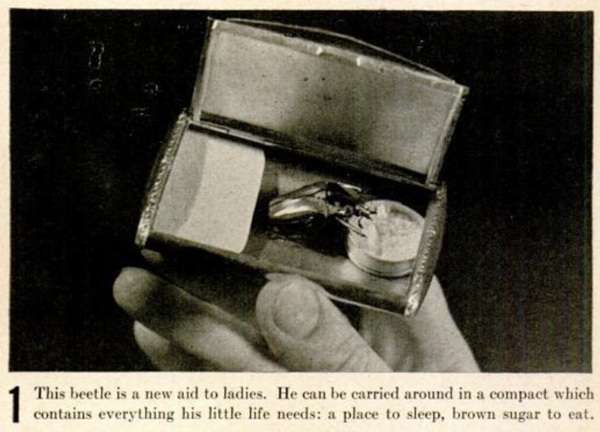
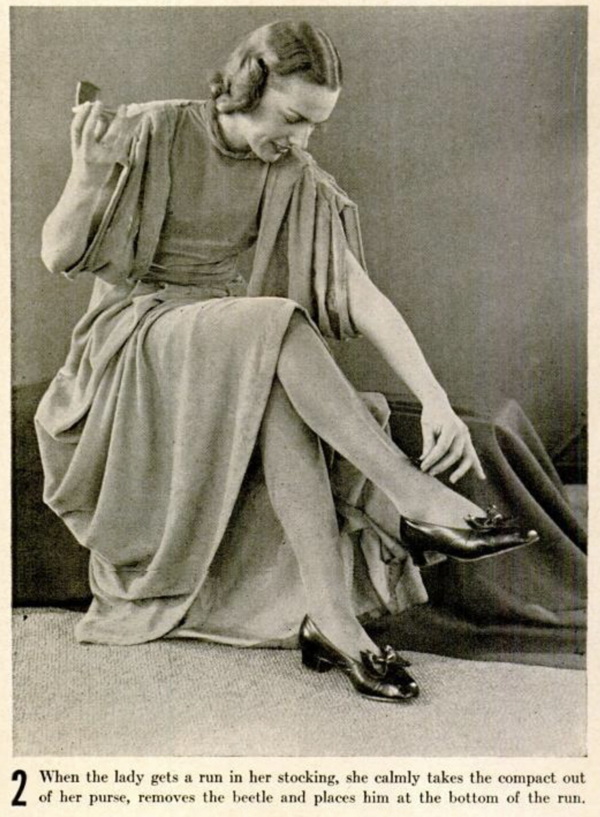
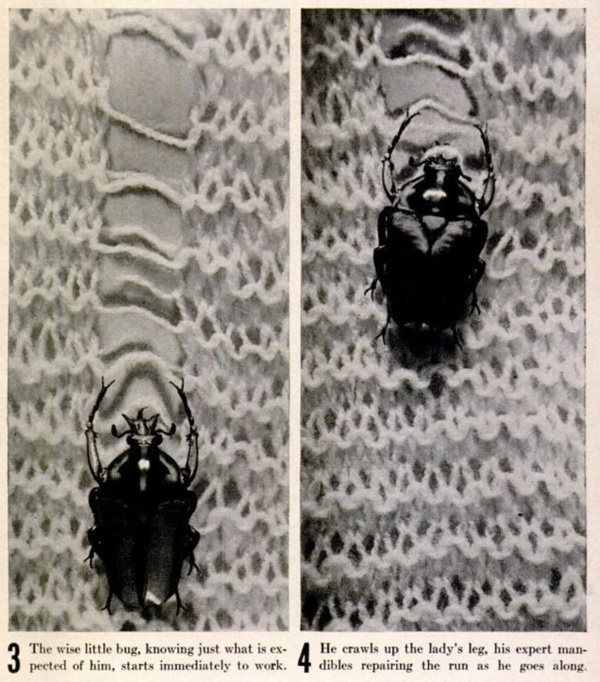
Posted By: Alex - Mon Apr 01, 2024 -
Comments (1)
Category: Holidays, Insects and Spiders, 1930s
The Princess Who Was Murdered by a Moth
The story goes that Princess Caravella of Italy was found dead in her bed, shot through the heart. Her husband was accused of her murder, but during the trial a police investigator convinced the jury that the Princess had actually been killed by a moth that singed its wings on a candle in her room, then fell onto a pistol lying on her bedside table, thereby causing the weapon to fire, shooting her through the heart.I doubt any part of this story is true. After all, I can't find any historical references to a "Princess Caravella" other than the ones about her strange death. But the story was printed repeatedly in newspapers during the first half of the twentieth, always presented as an odd but true tale.
The earliest account of the story I can find dates to 1895, where it was credited to the New York World. I assume a reporter for the New York World made it up.
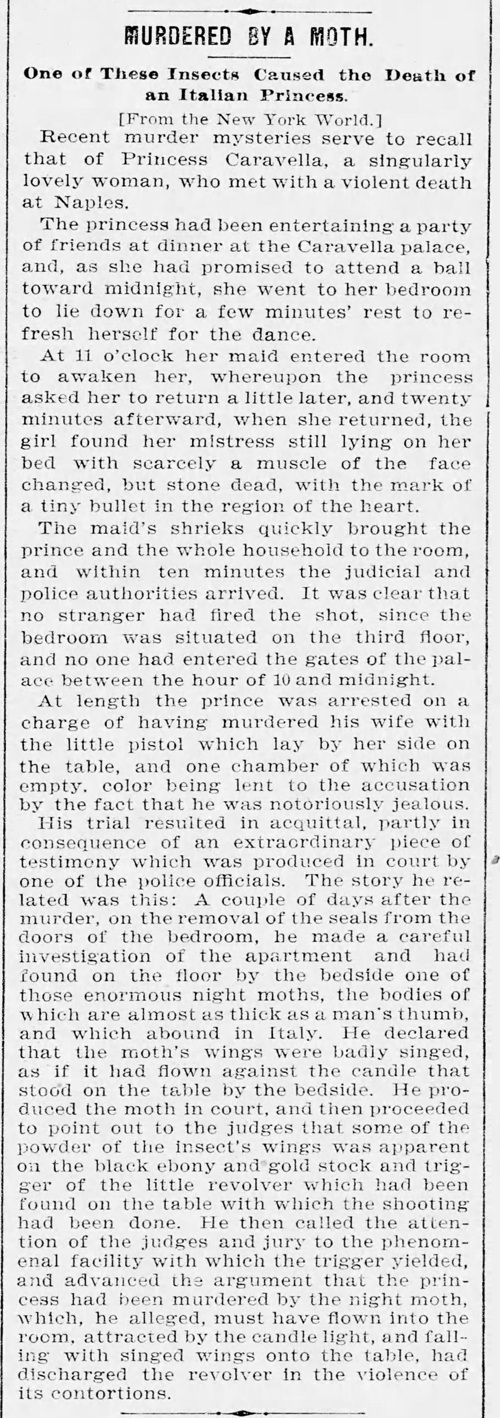
Chicago Chronicle - Dec 29, 1895
Here's a slightly shorter version of the story from 1937.
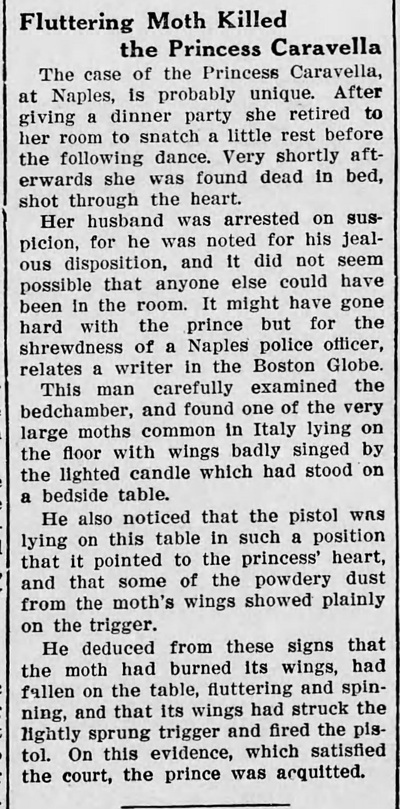
Tunkhannock New Age - Feb 18, 1937
I can't find the story in papers after the 1940s, but it did continue to pop up in books about odd trivia and weird deaths. For instance, below is a version that appeared in the 1985 weird-news book Own Goals by Graham Jones. Note that Jones identified Princess Caravella only as an "Italian wife," making the story seem more contemporary.
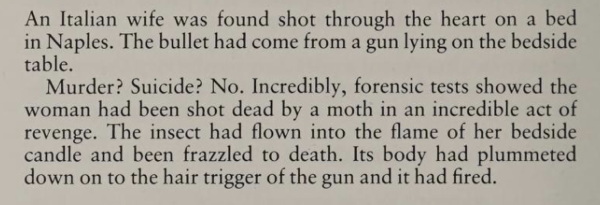
Posted By: Alex - Thu Mar 14, 2024 -
Comments (2)
Category: Death, Insects and Spiders, Nineteenth Century
Anting
A strange behavior engaged in by birds. From wikipedia:
Posted By: Alex - Sat Jan 27, 2024 -
Comments (6)
Category: Animals, Insects and Spiders

| Who We Are |
|---|
| Alex Boese Alex is the creator and curator of the Museum of Hoaxes. He's also the author of various weird, non-fiction, science-themed books such as Elephants on Acid and Psychedelic Apes. Paul Di Filippo Paul has been paid to put weird ideas into fictional form for over thirty years, in his career as a noted science fiction writer. He has recently begun blogging on many curious topics with three fellow writers at The Inferior 4+1. Contact Us |




